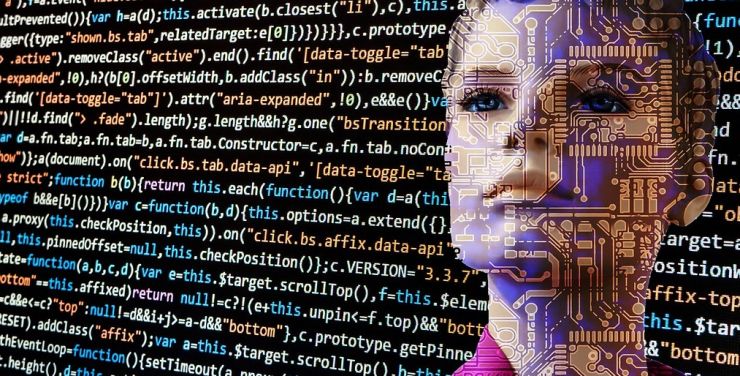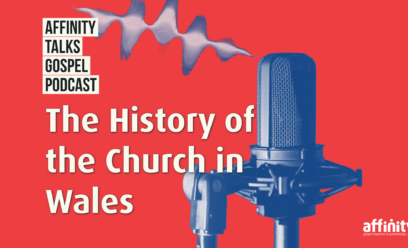Christianity and Transhumanism

The latest issue of Affinity’s Social Issues Bulletin is out now. It is free to download, as are all previous editions. One of the articles, by Dr Calum MacKellar, looks at advances in artificial intelligence and where this may be leading us in the not-so-distant future.
Humanity stands at a decisive moment in its history. This is because human beings are now creating technologies that will improve their capacities so dramatically that they may no longer really be human in the usual sense of that word, but transhuman or posthuman.[1] But is this what God had planned for humanity?
To answer this question, it may first be necessary to try to understand what the concepts of transhumanism and posthumanism actually mean.
Transhumanism
The prefix ‘trans’ (from the Latin for ‘across’) is generally used to describe that someone or something has moved across from, or beyond, a certain boundary. Accordingly, transhumanism is an ideology reflecting a willingness to move beyond the frontier of what is considered to be human. The term, itself, was developed by the British biologist Julian Huxley (1887-1975) who used it for the title of an influential 1957 article[2] to suggest that:
Up till now human life has generally been, as [the English Philosopher] Hobbes [1588-1679] described it, ‘nasty, brutish and short’; the great majority of human beings… have been afflicted with misery… [W]e can justifiably hold the belief that… the present limitations and miserable frustrations of our existence could be in large measure surmounted… The human species can, if it wishes, transcend itself – not just sporadically… but in its entirety, as humanity.[3]
In other words, transhumanism is a rejection of the assumption that human nature is a constant and that nature in general, or human nature in particular, should be protected and retained as an imperative. Thus, transhumanists (those who support transhumanism ideology)[4] accept an evolutionary account of human beings but are not content to remain passive and simply let biological and social influences direct the future of the human race. Instead, they would intentionally seek to control human evolution and direct it towards what they consider to be improved and enhanced descendants.[5] In so doing, they would use tools such as genetic manipulation, nanotechnology, cybernetics, robotics, informatics and computer simulation.[6]
Transhumanism also reflects an unhappiness and dissatisfaction with the current abilities of humanity.[7] It focuses on how human beings ought to be transformed so that they might flourish, live longer, healthier lives, avoid suffering, enjoy greater cognitive powers and an increased capacity to experience more robust and pleasurable inner states.[8],[9] However, transhumanism does not generally give a vision of the final ideal of future enhanced persons. Thus, progress is not measured by attaining some pre-set goal but by using technology to expand human choices. As such, transhumanism offers an ethical vision in which technological innovation is the central human achievement and thereby becomes the medium to attain authenticity, liberty and justice.[10]
Transhumanists would also welcome the bringing into existence of transhuman persons who are individuals who have moved across, or beyond, the distinct boundary of what is considered to be human, though some human characteristics may remain. In this context, transhuman persons can, for example, be considered as having bodies which may be recognisably human and include:
(1) Entirely biological transhuman persons such as:
- Biological synthetic humanoid persons (often defined as androids)
- Human-nonhuman interspecies persons
- Any other entirely biological artificial persons with body parts which resemble those of human beings including the brain
(2) Part-machine, part-biological transhuman persons (cyborgs) such as:
- Persons with machine bodies and human or non-human biological brains
- Persons with biological bodies and computer brains
- Persons who are a combination of the above
(3) Machine transhuman persons such as:
- Robots who look and act in a similar way to human persons
Posthumanism
The prefix ‘post’ (from the Latin for ‘after’ or ‘behind’) is generally used to describe the reality that someone or something is coming ‘after’, ‘later’, or ‘subsequent to’ in time. Accordingly, posthumanism is an ideology reflecting a willingness to eventually reach a stage in time where nothing which may be defined as human remains. In this regard, the American author N. Katherine Hayles characterises four different aspects of a posthuman future:[11]
- The prioritisation of information patterns over material substances
- The acceptance that consciousness is just a mere product of the physical
- The recognition that the human body is just an original form and substance of a being which can be upgraded or replaced
- An acknowledgement that human beings can be considered as intelligent machines, making the two interchangeable
Thus, a posthuman person is an individual who no longer expresses human characteristics in any significant manner. As the Swedish philosopher, Nick Bostrom, explains:
It is sometimes useful to talk about possible future beings whose basic capacities so radically exceed those of the present humans as to be no longer unambiguously human by our current standards. The standard word for such beings is ‘posthuman’.[12]
Generally, however, it is difficult to accurately describe the posthuman individual. In this regard, Hayles characterises such a being as ‘an amalgam, a collection of heretogeneous components, a material-informational entity whose boundaries undergo continuous construction and reconstruction.”[13] Thus posthuman beings would exist in a state that has moved completely beyond the boundary of what is considered human and would, for example, include:
(1) Biological posthuman persons, such as:
- Synthetic biological persons who no longer retain any human characteristics whatsoever
(2) Non-biological posthuman persons, such as:
- Virtual persons living in cyber-space (who are, for example, the result of a mind upload)
(3) Cyborg Posthumans
- Persons with a combination of the biological and machine but who no longer retain any human characteristics whatsoever
A Christian Perspective
Over recent years, a number of commentators have both welcomed and criticised transhuman and posthuman ideologies.[14] But because of the radical nature of such beliefs, a number of concerns may be presented from a Christian perspective which can now be examined.
i) Playing God
To begin with, concerns exist that the bringing into existence of such new kinds of persons may violate the divine prerogative of creating life. Under this argument, tinkering with the generation of persons is tantamount to ‘playing God’. However, it is often unclear what this expression actually means. For example, it may be countered that God always meant humanity to play God. Thus, in the same way as God created his human children in the garden of Eden, human beings were always meant to procreate their own children (and so, in a way, play at being God). The American theologian Jacob Shatzer indicates: ‘Maybe our lives, as those made in the image of God, should be lives of “playing” at being like God.’[15] He adds:
If Christianity means following Christ, imitating Christ, ‘playing at’ being Christ, ‘playing God’ can be reoriented. This ‘playing’ is not a ‘power play’ as our world has come to think of power – it is not exercising our knowledge and strength in remaking ourselves. Rather, it is humble play, accepting limitations and flourishing within them, following Christ in his suffering. This humble ‘playing God’ can impact the way practitioners and patients approach medical care, as well as the overall stance on posthumanism.[16]
In other words, it may only be when human beings cheat in the game of ‘playing God’ that ethical concerns arise as in the bringing into existence of transhuman and posthuman persons. As the UK-based theologian, Michael Burdett, explains, ‘playing God appeals to divinely ordained orders of creation’ which should be respected, adding:
Proponents of this position will often hold to some form of natural law. God’s intentions and directions for human beings, other creatures, and the rest of creation are at least in part visible in the way God has created the world. Having been ordained by God, these natural laws are not meant to be broken and doing so is an affront to the moral order.[17]
In this regard, bringing into existence transhuman and posthuman persons may be considered as a form of cheating at the game of playing God in that such a development would be considered unnatural by those who believe in natural laws given by the order of God’s creation.
ii) Human beings were always meant to be human
In any discussion of transhumanism and posthumanism it is also difficult to determine what is actually meant by human and what true humanity entails. In Christianity, this can only be achieved by looking to Jesus Christ, who is both the perfect image of God and the perfect definition of true humanity.[18] In this respect, the protestant Scottish-American theologian Nigel Cameron notes the central importance of human nature: ‘The classical Christian belief is that having been raised from the dead and ascended into heaven, he [Christ] “sat down” at the right hand of God the Father… Human nature has been chosen by God to be ours, and also to be his own.’[19] Similarly, the Scottish theologian Alan Torrance indicates that one of the most important elements of the Christian tradition is:
[T]he perception that in Jesus Christ we are presented not only with God but with what it is to be human in truth – that is, with the one who uniquely defines human nature as it is created and elected to be. It is in him – rather than in the originally created humanity, represented by the first Adam – that the telos of humanity is determined. He is the final or eschatos Adam, the true imago Dei, or imago Patris and, as such, defines and, indeed, constitutes humanity in its properly functional form as this involves our existing in ‘communion’ with God.[20]
It follows that in order to understand what is really meant by human it is necessary to look to Jesus Christ, who redeems new humanity. [21] As Torrance also stresses: ‘Clearly, from a Christian perspective there is indeed a true human nature that must be conceived as invariant and is conceived in terms of participation within the “new humanity”.’[22] Cameron adds:
From this perspective, it is plain that all efforts at the enhancement of human nature – with enhancement defined in terms of a break with the human analogy – are theologically excluded since they have the effect of reshaping that human nature that is both God given and God taken. The exemplar of Homo sapiens is the glorified Jesus Christ.[23]
This also means that questions relating to the ‘human’ nature of new persons, such as transhuman or posthuman persons, can only be seen through Jesus Christ and the new human nature which he has redeemed. Though they may have been denied humanity through sin when first brought into existence in this fallen world, these new kinds of transhuman and posthuman persons will eventually be brought, through death, into the presence of the embodied Christ. They will then put on the true humanity of Christ and be redeemed with the entirely human nature for which they were destined.[24]
iii) Human beings were always meant to be vulnerable, weak and limited
In transhumanism and posthumanism, one of the declared aims is to go beyond the human in order to address humanity’s limitedness, weakness and suffering. However, this may then undermine the crucial human concepts of compassion (Latin for ‘suffering with’) or empathy (Greek for ‘feeling in’), concepts that are present even in the perfect triune God. Indeed, being able to suffer with others is maybe what makes us, as human beings, most interesting and indeed most human. The Scottish theologian, James Eglinton explains: ‘A Christian theological account of “being human” is shaped by the perfect human, Jesus Christ, perfect in love and willingly vulnerable. Significantly, that view ties together the embrace of vulnerability with the capacity to love.’[25] In this connection, the International Theological Commission of the Roman Catholic church indicates:
Changing the genetic identity of man as a human person through the production of an infrahuman being is radically immoral. The use of genetic modification to yield a superhuman or being with essentially new spiritual faculties is unthinkable, given that the spiritual life principle of man – forming the matter into the body of the human person – is not a product of human hands and is not subject to genetic engineering… A man can only truly improve by realizing more fully the image of God in him by uniting himself to Christ and in imitation of him.[26]
Human beings, in a way, were always meant to be completely dependent on God in their vulnerability and limitedness. This is because without vulnerability, sacrificial love cannot exist. In Christianity, God also knows what suffering means, creates his children with a capacity to suffer, accepts to suffer for and with his children, and demonstrates his suffering for his children through the marks on his hands, feet and side for all eternity.
Conclusion
Transhumanist and posthumanist ideologies are often presented in an extremely optimistic manner, emphasising a very exciting future brought about by the ingenuity of humanity to harness technological developments. As the American Protestant theologian, Ted Peters, indicates:
The transhumanist confidence in the advance of technology draws upon a utopian vision, a vision of future human fulfillment or even posthuman fulfillment in a kingdom where rational intelligence has transcended its previous biological imprisonment. The information pattern which is our mind will be transferred from biological brains to computer substrates or even the cloud, escaping the vicissitudes of bodily disease, deterioration, and death. We will become Homo cyberneticus. Not only as individuals but also as a social community and even as a cosmic community we will experience ecstatic human flourishing, the abundant life which previous religious visionaries could only dream of.[27]
But interestingly, the concept of transhuman and posthuman beings is not new. For instance, the story of Frankenstein published in 1818 by the English novelist Mary Shelley (1797-1851) tells the story of a transhuman monster, generated by a scientist named Victor Frankenstein. But it is a story which can also be used as a warning to any individuals seeking to bring transhuman and posthuman persons into existence. For example, Frankenstein looks forward with excitement, at first, to the day when his new being would come into existence: ‘A new species would bless me as its creator and source; many happy and excellent natures would owe their being to me. No father could claim the gratitude of his child so completely as I should deserve theirs’.[28] But the book soon reveals how mistaken he was, when the monster he generates indicts Frankenstein with all his suffering and loneliness:
Unfeeling, heartless creator! You had endowed me with perceptions and passions, and then cast me abroad an object for the scorn and horror of mankind. But on you only had I any claim for pity and redress, and from you I determined to seek that justice which I vainly attempted to gain from any other being that wore the human form.[29]
In a similar way, it is very likely that future transhuman and posthuman persons will feel angry and bewildered if they are not procreated from the embodied love of their parents. Again, this is movingly illustrated by Frankenstein’s creature and his search for identity. Indeed, though Frankenstein had intended his creature to be attractive, the experiment is a disaster and results in a monster who he then completely rejects and abandons to his own predicament. But the nameless creature goes in search for his generator since he realises that Frankenstein is the real origin and cause of his very existence and life, and that he must be the answer to his deep existential angst. The monster, in a way, is looking for answers as to why he was created while seeking to understand the deep sense of rejection and abandonment he experiences. His anguish and distress are deeply moving in his exclamation: ‘My person was hideous and my stature gigantic. What did this mean? Who was I? What was I? Whence did I come? What was my destination? These questions continually recurred, but I was unable to solve them.’[30]
Likewise, it is possible that new transhuman and posthuman persons will feel completely lost in their very existence and identity, making their generation deeply problematic and even unethical because of all the likely suffering they may experience.
To conclude, it may be appropriate to return to Genesis 1:26-31 which emphasises God’s wonderful creation:
Then God said, ‘Let us make mankind in our image, in our likeness’…
So God created mankind in his own image,
in the image of God he created them…
God saw all that he had made, and it was very good.
In transhumanist and posthumanist ideologies, however, this could be replaced with:
Transhumanists saw all that God had made,
and it was very insufficient.
They were certain that they could do far better.
But in attempting to become like God, or even better than God, transhumanists can only cheat at the game of playing God – a game that requires sacrificial love.
Dr. Calum MacKellar
Dr. Calum MacKellar is the Director of Research of a medical ethics charity in Scotland, Fellow with the Centre for Bioethics & Human Dignity at Trinity International University in Chicago, USA and, since 2010, has been a Visiting Lecturer and Visiting Professor in Bioethics at St Mary’s University in London.
[1] Ronald Cole-Turner, Afterword – Concluding Reflections: Yearning for Enhancement, in Calvin Mercer & Derek F. Maher (eds) Transhumanism and the Body, New York: Palgrave MacMillan (2014), 174-191 (175).
[2] However, the word actually derives from an earlier 1940 paper by the Canadian philosopher William Lighthall (1857-1954); Harrison, Peter and Wolyniak, Joseph, ‘The History of “Transhumanism’”. Notes and Queries 62 (2015), 465-7.
[3] Huxley, Julian, ‘Transhumanism’, in New Bottles for New Wine: Essays, London: Chatto & Windus, (1957), 13-17.
[4] Bostrom indicates: ‘A transhumanist is simply someone who advocates transhumanism’; Nick Bostrom, Introduction – The Transhumanist FAQ: A General Introduction, in Calvin Mercer & Derek F. Maher (eds) Transhumanism and the Body, New York: Palgrave MacMillan (2014), 1-17 (4).
[5] Steve Fuller and Calvin Mercer, Introduction, in Calvin Mercer & Derek F. Maher (eds) Transhumanism and the Body, New York: Palgrave MacMillan (2014), iii -vi (v).
[6] Michael Burdett, Technology and the Rise of Transhumanism, Grove Books, Cambridge (2014), 5.
[7] Michael Burdett and Victoria Lorrimar, Creatures Bound for Glory: Biotechnological Enhancement and Visions of Human Flourishing, Studies in Christian Ethics (2019) Vol. 32(2), 241-253 (243).
[8] Ibid., 245.
[9] Nick Bostrom, Introduction – The Transhumanist FAQ: A General Introduction, In Calvin Mercer & Derek F. Maher (eds) Transhumanism and the Body, New York: Palgrave MacMillan (2014), 1-17 (3).
[10] Hava Tirosh-Samuelson, Transhumanism as a secularist faith, Zygon (2012) Vol. 47, No. 4, 728.
[11] Hayles, N. Katherine, How we became Posthuman: Virtual bodies in cybernetics, literature, and informatics, Chicago and London: University of Chicago Press (1999), 2-3.
[12] Bostrom, Transhumanism and the Body, 3.
[13] Hayles, How we became Posthuman: Virtual bodies in cybernetics, literature, and informatics, 3.
[14] Mercer & Maher (eds) Transhumanism and the Body.
[15] Jacob Shatzer, A Limited Image? Practitioners, Patients, and Playing God, Ethics & Medicine (2018) Vol. 34(1), 21-29 (21).
[16] Ibid., 26.
[17] Burdett, Technology and the Rise of Transhumanism, 12.
[18] John F. Kilner, Dignity and Destiny: Humanity in the Image of God, Grand Rapids: Eerdmans (2015), 73.
[19] Nigel M. de S. Cameron and Amy Michelle DeBaets, Germline Gene Modification and the Human Condition before God, in Ronald Cole-Turner (ed.) Design and Destiny: Jewish and Christian Perspectives on Human Germline Modification, Cambridge: Massachusetts, The MIT Press (2008), 105.
[20] Alan J. Torrance, ‘Is there a distinctive human nature? Approaching the question from a Christian epistemic base’, Zygon (2012) 47(4), 907.
[21] Ibid., 47(4), 912.
[22] Ibid., 47(4), 913.
[23] de S. Cameron and DeBaets, Germline Gene Modification and the Human Condition before God, 105.
[24] Calum MacKellar, The Image of God, Personhood and the Embryo, SCM Press (2017), 119-120.
[25] James Eglinton, Domination and Vulnerability: Herman Bavinck on Posthumanism in the Shadow of Friedrich Nietzsche, in: Calum MacKellar & Trevor Stammers (eds), The Ethics of Generating Posthumans, Bloomsbury Academic (2021) In Press.
[26] International Theological Commission, Communion and Stewardship: Human Persons Created in the Image of God (2002) paragraph 91.
[27] Ted Peters, Playing God with Frankenstein, Theology and Science, (2018) 16:2, 145-150, (147).
[28] In David H. Guston, Ed Finn and Jason Scott Robert (eds.), Mary Shelley, Frankenstein, Annotated for Scientists, Engineers, and Creators of All Kinds, Cambridge, Massachusetts: The MIT Press (2017), 37.
[29] Ibid., 116.
[30] Guston, Finn and Robert (eds.), Mary Shelley, Frankenstein, Annotated for Scientists, Engineers, and Creators of All Kinds, 106.
Stay connected with our monthly update
Sign up to receive the latest news from Affinity and our members, delivered straight to your inbox once a month.



